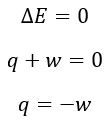6A. State whether each of the following is true or false. Explain your reasoning in each case. (a) q must be zero for an isothermal process (b) q=0 for every cyclic process [A cyclic process is one that begins in one state and undergoes several steps which ultimately bring the system back to the same initial state.] (c) DU=0 for every cyclic process. (d) DT=0 for every adiabatic process in a closed system.
6A. State whether each of the following is true or false. Explain your reasoning in each case. (a) q must be zero for an isothermal process (b) q=0 for every cyclic process [A cyclic process is one that begins in one state and undergoes several steps which ultimately bring the system back to the same initial state.] (c) DU=0 for every cyclic process. (d) DT=0 for every adiabatic process in a closed system.
Chemistry
10th Edition
ISBN:9781305957404
Author:Steven S. Zumdahl, Susan A. Zumdahl, Donald J. DeCoste
Publisher:Steven S. Zumdahl, Susan A. Zumdahl, Donald J. DeCoste
Chapter1: Chemical Foundations
Section: Chapter Questions
Problem 1RQ: Define and explain the differences between the following terms. a. law and theory b. theory and...
Related questions
Question
![6A. State whether each of the following is true or false.
Explain your reasoning in each case. (a) q must be zero for an
isothermal process (b) q=0 for every cyclic process [A cyclic
process is one that begins in one state and undergoes several
steps which ultimately bring the system back to the same initial
state.] (c) DU=0 for every cyclic process. (d) DT=0 for every
adiabatic process in a closed system.](/v2/_next/image?url=https%3A%2F%2Fcontent.bartleby.com%2Fqna-images%2Fquestion%2F25277a46-3669-47e2-8df5-90d0631795eb%2F47463ef4-cae7-4f6a-92bc-a49dfa87af58%2Fiich72i_processed.jpeg&w=3840&q=75)
Transcribed Image Text:6A. State whether each of the following is true or false.
Explain your reasoning in each case. (a) q must be zero for an
isothermal process (b) q=0 for every cyclic process [A cyclic
process is one that begins in one state and undergoes several
steps which ultimately bring the system back to the same initial
state.] (c) DU=0 for every cyclic process. (d) DT=0 for every
adiabatic process in a closed system.
Expert Solution
Step 1
(a) According to the first law of thermodynamics, the internal energy change of the system is given by:

Here delta E = change in internal energy
q = heat transfer of the process
w = work done during the process
The internal energy of the system is a function of the temperature. For the isothermal process:

Thus the given statement is false.
Step by step
Solved in 4 steps with 2 images

Knowledge Booster
Learn more about
Need a deep-dive on the concept behind this application? Look no further. Learn more about this topic, chemistry and related others by exploring similar questions and additional content below.Recommended textbooks for you

Chemistry
Chemistry
ISBN:
9781305957404
Author:
Steven S. Zumdahl, Susan A. Zumdahl, Donald J. DeCoste
Publisher:
Cengage Learning

Chemistry
Chemistry
ISBN:
9781259911156
Author:
Raymond Chang Dr., Jason Overby Professor
Publisher:
McGraw-Hill Education

Principles of Instrumental Analysis
Chemistry
ISBN:
9781305577213
Author:
Douglas A. Skoog, F. James Holler, Stanley R. Crouch
Publisher:
Cengage Learning

Chemistry
Chemistry
ISBN:
9781305957404
Author:
Steven S. Zumdahl, Susan A. Zumdahl, Donald J. DeCoste
Publisher:
Cengage Learning

Chemistry
Chemistry
ISBN:
9781259911156
Author:
Raymond Chang Dr., Jason Overby Professor
Publisher:
McGraw-Hill Education

Principles of Instrumental Analysis
Chemistry
ISBN:
9781305577213
Author:
Douglas A. Skoog, F. James Holler, Stanley R. Crouch
Publisher:
Cengage Learning

Organic Chemistry
Chemistry
ISBN:
9780078021558
Author:
Janice Gorzynski Smith Dr.
Publisher:
McGraw-Hill Education

Chemistry: Principles and Reactions
Chemistry
ISBN:
9781305079373
Author:
William L. Masterton, Cecile N. Hurley
Publisher:
Cengage Learning

Elementary Principles of Chemical Processes, Bind…
Chemistry
ISBN:
9781118431221
Author:
Richard M. Felder, Ronald W. Rousseau, Lisa G. Bullard
Publisher:
WILEY